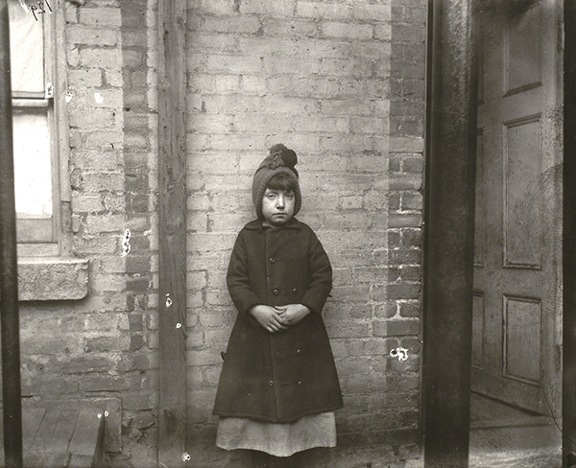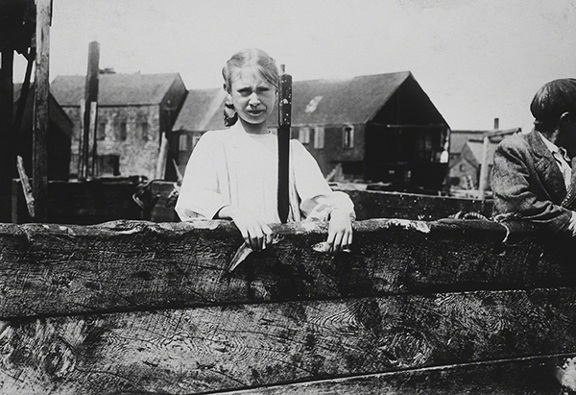Documenting Child Labor: Jacob Riis
If we think that only adult women have played an important role in American history, then we are sadly mistaken. Before child labor laws were passed in the United States (1 September 1916), young women had jobs that were just as demanding as those held by adults, often for bare minimum compensation.
 |
| Jacob Riis (1849–1914, U.S., born Denmark), “I Scrubs” – Katie, from the West 52nd Industrial School, Who Keeps House on West Forty-Ninth Street, from the book Children of the Poor (1892), 1890. Gelatin silver print on paper, 4" x 5" (10.2 x 12.7 cm). © 2024 The Museum of Modern Art, New York. (MOMA-P0353) |
Journalist and photographer Jacob Riis took photographic expeditions into New York’s slums, presenting his findings as lectures in 1888 and the book How the Other Half Lives in 1890. Devoted to reforming poor neighborhoods, Riis published his book Children of the Poor (1892)—a sequel to How the Other Half Lives—after working with a friend from New York's Health Department. The book was filled with data on public health, education, and crime.
Unlike many of his previous photographic journeys into the tenements, Riis photographed most of his subjects for the Children of the Poor during the day. Rather than surprise tenement inhabitants with a bright flash, Riis built a rapport with his subjects before photographing them. For children like Katie, who kept house for her older sister and two brothers (who all worked), Riis took notes on their lives, including quotes, to accompany the photographs in his books.
The use of photography as social documentation was not a conscious movement until late in the 1800s, when Western countries were becoming rapidly industrialized. Reform groups in many countries began to address social issues. Because photography was considered most valuable as a document of visual fact, it was inevitable that the medium would be used to document social ills. However, social documentation was not characterized by random, unposed straight images. The photographers carefully composed their shots and chose just the right moment to imbue fact with feeling.
The flood of immigrants from Europe at the turn of the century gave rise to overcrowding and poverty in large American cities. Lack of jobs and housing created terribly overcrowded tenements and homelessness. By 1900, reformers became concerned with raising the standard of living for the growing population of urban poor in America. Photographers were convinced that documenting squalid conditions would shame the public into action.
Riis was one of fourteen children born to a poor schoolteacher in Ribe, Denmark. At a young age, he developed a sensitive disposition and faith in fellow human beings that would serve him well in his adult life. Trained in woodworking, Riis migrated to New York in 1870. After several years of abject poverty, Riis secured a position as an editor for the South Brooklyn News, gaining skills as a reporter. By 1877, he joined the New York Tribune, where he was assigned as a crime reporter.
For fifteen years with the New York Tribune, Riis followed police officers and detectives into rough neighborhoods of the Lower East Side in Manhattan. His own upbringing in poverty and his early meager existence in New York fostered an empathy in Riis for impoverished immigrants and the squalid conditions in which they lived. Realizing that words alone would not sway most people, Riis taught himself photography and began carrying a camera with him. The magnesium flash, developed in 1860s, helped Riis illuminate the darkest corners of New York's tenements to expose the terrible conditions to the middle class.
Although Riis never investigated the causes for the squalor among the immigrant poor, his reporting on the conditions—particularly about the lot of children—helped enact major reforms in New York housing. His publications How the Other Half Lives, Out of Mulberry Street (1898), and The Battle with the Slum (1902) were groundbreaking efforts in the field of social justice.
The photographs of Lewis Wickes Hine continued to shed light on the plight of child workers.
 |
| Lewis Wickes Hine (1874–1940, U.S.), Minnie Thomas, 9 years old, showing average size of sardine knife used in cutting. Some of the children use a knife as large as this. Minnie works regularly in Seacoast Canning Co., Factory 7, mostly in the packing room, and when very busy works nights. Cuts some, also cartons. She says she earns $2.00 some days, packing. Location: Eastport, Maine, August 1911. Gelatin silver print on paper, 4 ¾" x 7 1/16" (12 x 18 cm). Private Collection, Chicago. Image © 2024 Davis Art Images. (8S-20647) |
In 1908, Hine quit teaching to become a photographer and investigator for the National Child Labor Committee. He traveled widely—from Maine to Texas—between 1908 and 1916 documenting child labor abuses. Hine called his photographs “photointerpretations” because he felt they were interpretive. However, Hine was accomplished in composition, taking numerous shots of the same subject until one served its purpose. In Minnie Thomas, Hine juxtaposed a huge knife with a young girl for maximum impact. Although documentary, it borders on Pictorialism in the drama of the image.
Hine felt that photos like this were absolute proof of the ills of child labor abuse that no written denial could contradict. The photographs were used pamphlets, magazines, books, lectures and traveling exhibits, many of which Hine designed. Minnie Thomas came from an extensive series of images documenting seafood workers.
Correlations to Davis programs: Experience Art: 2.1; The Visual Experience 4E: pp. 338–339; Focus on Photography 2E: Chapter 6


Comments